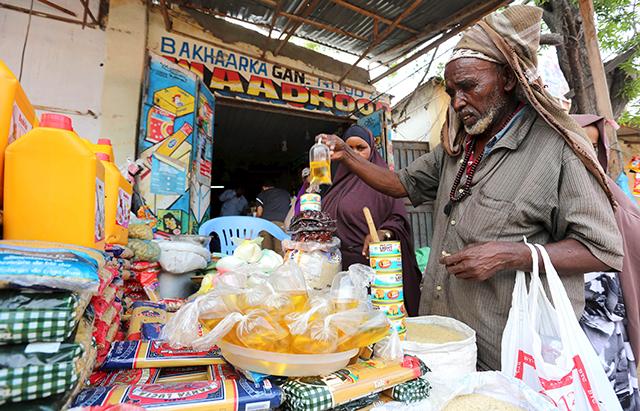
Thursday October 29, 2015
By Mark Porubcansky

A Somali man buys cooking oil at a market in Mogadishu.
In recent years, experts hoping to help rebuild their country have trickled home to Somalia. So have some hardy entrepreneurs. And then there were the angry young men seeking meaning in the embrace of violent extremists.The numbers in all cases have been limited, a reflection of the devastation and chaos resulting from a quarter-century of war — which is still pushing people to leave. Somalis are part of the flood of migrants who have overwhelmed Europe this year. But it also appears that the numbers returning home to Somalia might start to grow. There won’t be a flood anytime soon, but there might be a slow stream.
Trouble in the neighborhood, and the strain of hosting long-term refugee populations have made countries such as Yemen and Kenya less welcoming. At the same time, small improvements in security and opportunities are encouraging aid agencies to act on their always-present, often-impossible goal of returning refugees to their home countries.
A conference in Europe last week received pledges of more than $100 million toward the goal of helping 135,000 Somalis return home by the end of 2017. (To help put that number in perspective, about 40,000 Minnesotans have Somali ancestry.)
Altogether, officials working for the office of the U.N. High Commissioner for Refugees say about $500 million will be needed to improve security; repair infrastructure; provide water, sanitation, and shelter, and offer more access to education and job opportunities for people who want to go back.
The U.N. acknowledges that circumstances aren’t right yet for an even bigger return of refugees. But given the tough conditions in Somalia, even this number seems ambitious.
The U.N.’s refugee agency announced this month that 5,000 refugees had headed home to Somalia since December from the mammoth Dadaab camp in northern Kenya, home to about 350,000 people. It said another 4,500 had signed up to go back.
Those numbers amount to a tiny percentage of the overall number of Somalis who have fled their country or are displaced within it. The U.N. puts that total at about 2 million – slightly more than a million inside the country, and slightly less than a million outside its borders. More than 400,000 are in Kenya, a quarter-million in Ethiopia and roughly 200,000 in Yemen.
The donor conference coincided with the release of a U.N. report that lays out the challenges ahead.
The presence of a 22,000-member African Union military force, a separate incursion by Kenyan forces and the occasional U.S. drone strike have helped push back Islamic militants of the Al Shabaab group.
But as Al Shabaab recedes, Somali clan, business and political networks are trying to take control of turf and resources, it says. Al Shabaab, although brutal, had managed to suppress some conflicts over land and water.
Corruption is a huge problem. Even the forces fighting Al Shabaab – Somali and African Union — stand accused of serious human rights abuses. And despite losing top leaders and largely being pushed out of the cities, Al Shabaab has adapted. It remains a threat to attack military forces as well as politicians and civilian targets in Mogadishu, other cities and beyond Somalia’s borders.
Almost three-quarters of Somalia’s people live in poverty, according to the United Nations. An annual survey of the quality of governance in African countries released earlier this month put Somalia dead last.
For every returnee success story in Somalia there seems to be a tale of tragedy, like that of Abdullahi Anshoor of Brooklyn Park, who returned to help rebuild Mogadishu but was shot to death last November by gunmen who took his car.
In 2013, Al Shabaab fighters attacked an upscale mall in Nairobi, killed 67 people and held out for several days. The most recent example was a terror attack on Garissa University in northeast Kenya in April, in which 147 people died. Witnesses said Al Shabaab attackers singled out Christians to be killed.
The Kenyan government suspects that Al Shabaab uses Dadaab to harbor its militants. After the Garissa attack, it demanded that the camp be closed. That hasn’t happened, but it adds urgency to the international community’s search for alternatives.
There is a separate flow of returnees from Yemen because of the civil war gripping that country.
As the BBC reports, nearly 30,000 Somalis have headed home from Yemen because ofheavy fighting that has consumed the country this year.
There are regional and sectarian elements to the fighting. Extremist groups like Al Qaeda and the Islamic State have a stake. Somali refugees don’t; they have fled to Yemen over the years as a simple matter of survival.
Now, the scramble to survive is taking them back home.